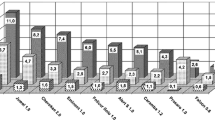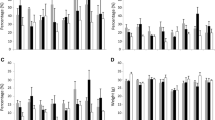Abstract
Samples of Florunner peanuts were collected throughout a period of late-season drought stress with mean geocarposphere temperatures of 29 and 25 °C, and determinations of maturity, kernel water activity (aw), percent moisture, capacity for phytoalexin production, and aflatoxin contamination were made. Results showed an association between the loss of the capacity of kernels to produce phytoalexins and the appearance of aflatoxin contamination. Kernel aw appeared to be the most important factor controlling the capacity of kernels to produce phytoalexins. Mature peanuts possessed additional resistance to contamination that could not be attributed solely to phytoalexin production. Kernel moisture loss was accelerated in the 29 °C treatment compared to the 25 °C treatment, and data indicated that the higher soil temperature also favored growth and aflatoxin production by Aspergillus flavus in peanuts susceptible to contamination.
Similar content being viewed by others
References
Aguamah GE, Langcake P, Leworthy DP, Page JA, Pryce RJ, Strange RN. Two novel stilbene phytoalexins from Arachis hypogaea. Phytochemistry 1981; 20: 1381–83.
American Society of Agricultural Engineers. ASAE S410.1. In: Agricultural Engineers Yearbook. St. Joseph, MI, 1983.
Blankenship PD, Cole RJ, Sanders TH, Hill RA. Environmental control plot facility with manipulable soil temperature. Oleagineux 1983; 38: 615–20.
Blankenship PD, Cole RJ, Sanders TH, Hill RA. Effect of geocarposphere temperature on pre-harvest colonization of drought-stressed peanuts by Aspergillus flavus and subsequent aflatoxin contamination. Mycopathologia 1984; 85: 69–74.
Cole RJ, Blankenship PD, Hill RA, Sanders TH. Effect of geocarposphere temperature on preharvest colonization of drought stressed peanuts by A. flavus and subsequent aflatoxin contamination. In Kurata H, Ueno Y, eds. Toxigenic fungi — their toxins and health hazard. New York: Elsevier, 1984; 44–51.
Cole RJ, Hill RA, Blankenship PD, Sanders TH, Garren KH. Influence of irrigation and drought stress on invasion of Aspergillus flavus of corn kernels and peanut pods. Dev Ind Microbiol 1982; 23: 229–36.
Cole RJ, Sanders TH, Hill RA, Blankenship PD. Mean geocarposphere temperatures that induce preharvest aflatoxin contamination of peanuts under drought stress. Mycopathologia 1985; 91: 41–46.
Dickens JW, Satterwhite JB, Sneed RE. Aflatoxin-contaminated peanuts produced on North Carolina farms in 1968. J Am Peanut Res Educ Assoc 1973; 5: 48–58.
Diener UL, Davis ND. Limiting temperature and relative humidity for growth and production of aflatoxin and free fatty acids by Aspergillus flavus in sterile peanuts. J Am Oil Chem Soc 1967; 44: 259–63.
Diener UL, Davis ND. Effect of environment on aflatoxin production in freshly dug peanuts. Trop Sci 1968; 10: 22–28.
Diener UL, Davis ND. Aflatoxin formation in peanuts by Aspergillus flavus. Ala Agric Exp Stn Bull 493, Auburn University, AL, 1977; 14–15.
Dorner JW, Cole RJ. Rapid determination of aflatoxins in raw peanuts by liquid chromatography with postcolumn iodination and modified minicolumn cleanup. J Assoc Off Anal Chem 1988; 71: 43–47.
Henning R. The hull-scrape method to determine when to dig peanuts. The Peanut Farmer 1983; 19(8): 11–14.
Hill RA, Blankenship PD, Cole RJ, Sanders TH. Effect of soil moisture and temperature on preharvest invasion of peanuts by the Aspergillus flavus group and subsequent aflatoxin development. Appl Environ Microbiol 1983; 45: 628–33.
Ingham JL. 3,5,4′-trihydroxystilbene as a phytoalexin from groundnuts (Arachis hypogaea). Phytochemistry 1976; 15: 1791–93.
Keen NT. The isolation of phytoalexins from germinating seeds of Cicer arietinum, Vigna sinensis, Arachis hypogaea, and other plants. Phytopathology 1975; 65: 91–92.
Keen NT, Ingham JL. New stilbene phytoalexins from American cultivars of Arachis hypogaea. Phytochemistry 1976; 15: 1794–95.
McDonald D, Harkness C. Aflatoxin in groundnut crop at harvest in Northern Nigeria. Trop Sci 1967; 9: 148–61.
Pettit RE, Taber RA, Schroeder HW, Harrison AL. Influence of fungicides and irrigation practice on aflatoxin in peanuts before digging. Appl Microbiol 1971; 22: 629–34.
Porter DM, Garren KH. An analysis of endogeocarpic microflora of peanuts in Virginia. Trop Sci 1968; 10: 100–06.
Sanders TH, Cole RJ, Blankenship PD, Hill RA. Relation of environmental stress duration to Aspergillus flavus invasion and aflatoxin production in preharvest peanuts. Peanut Sci 1985; 12: 90–93.
Sanders TH, Hill RA, Cole RJ, Blankenship PD. Effect of drought on occurrence of Aspergillus flavus in maturing peanuts. J Am Oil Chem Soc 1981; 58: 966A-70A.
Vidhyasekaran P, Lalithakumari D, Govindaswamy CV. Production of a phytoalexin in groundnut due to storage fungi. Indian Phytopathol 1972; 25: 240–45.
Williams EJ, Drexler JS. A non-destructive method for determining peanut pod maturity. Peanut Sci 1981; 8: 131–41.
Williams EJ, Monroe GE. Impact blasters for peanut pod maturity determination. Trans Am Soc Agric Eng 1986; 29: 263–66, 275.
Wilson DM, Stansell JR. Effect of irrigation regimes on aflatoxin contamination of peanut pods. Peanut Sci 1983; 10: 54–56.
Wotton HR, Strange RN. Circumstantial evidence for phytoalexin involvement in the resistance of peanuts to Aspergillus flavus. J Gen Microbiol 1985; 131: 487–94.
Wotton HR, Strange RN. Increased susceptibility and reduced phytoalexin accumulation in drought-stressed peanut kernels challenged with Aspergillus flavus. Appl Environ Microbiol 1987; 53: 270–73.
Author information
Authors and Affiliations
Additional information
Mention of a trademark or proprietary product does not constitute a guarantee or warranty of the product by the U.S. Department of Agriculture and does not imply its approval to the exclusion of other products that may also be suitable.
Rights and permissions
About this article
Cite this article
Dorner, J.W., Cole, R.J., Sanders, T.H. et al. Interrelationship of kernel water activity, soil temperature, maturity, and phytoalexin production in preharvest aflatoxin contamination of drought-stressed peanuts. Mycopathologia 105, 117–128 (1989). https://doi.org/10.1007/BF00444034
Accepted:
Issue Date:
DOI: https://doi.org/10.1007/BF00444034




